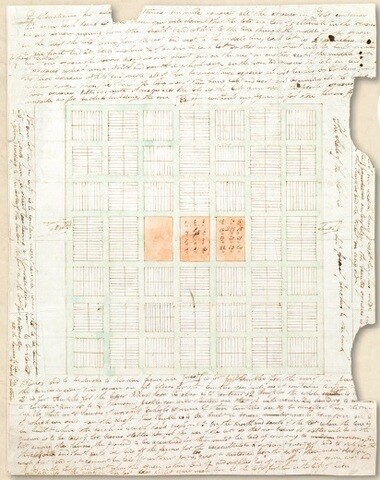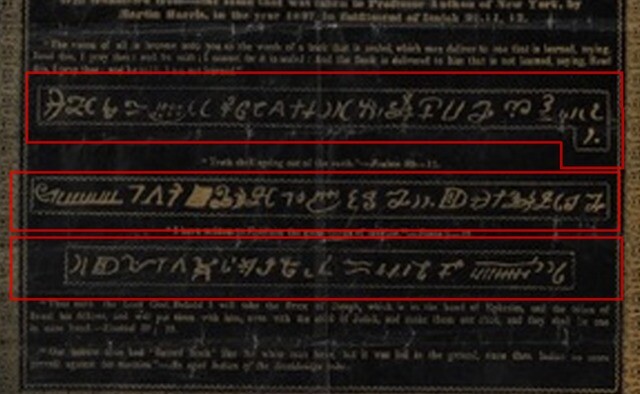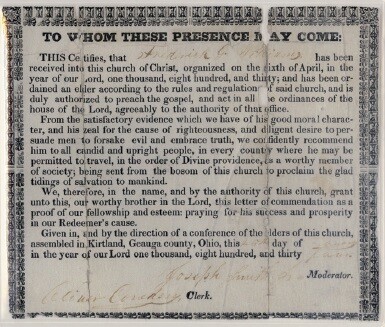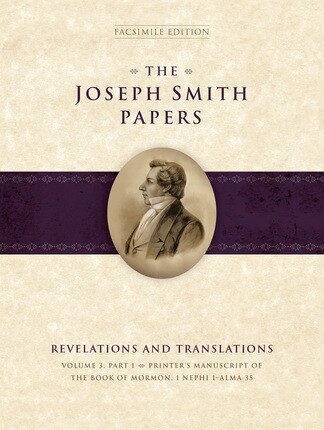Did you know that early Church leaders originally planned to have 24 temples in Jackson County, Missouri? Or that several brethren had a vision of Jesus Christ and Heavenly Father during a meeting of the School of the Prophets? Read on to learn more fascinating facts you might not have known about Church history.
The Joseph Smith Papers Project has undertaken a huge effort to gather all existing documents relating to Joseph Smith. Here are 20 lesser-known facts about Joseph Smith and the early Saints we’ve discovered along the way.
1. Not all of Joseph Smith’s revelations were published in the Doctrine and Covenants.
Joseph Smith received multiple revelations that were apparently never written down, but even some of the revelations that were recorded ended up not being included in published revelation collections. For instance, Joseph Smith received a revelation on May 15th, 1831, explaining what was to be done with Frederick G. Williams’s farm in Kirtland, where the Joseph Smith Sr. family and other Church members had been living and working. The revelation also counseled members arriving in Ohio from New York about what to do with their money. They were told to “save the money that it may be consecrated to purchase lands in the West for an everlasting enheritance.”
2. Original plans for the city of Zion in Missouri included 24 temples.
In June 1833, the presidency of the high priesthood— Joseph Smith, Sidney Rigdon, and Frederick G. Williams— began creating a master plan for the city of Zion, which was intended to be built in Jackson County, Missouri. They drew a plat of the city that included lots for 24 houses of the Lord, or temples, in the center of the city. An explanation written on the plat indicated the city could accommodate up to 20,000 people, though that estimate was a trifle high based on the number of residencies planned for.

Images courtesy of the LDS Church History Department.
The plat was sent to Missouri Church leaders along with a letter and an architectural plan for the first House of the Lord to be built in the city. However, by the time these items arrived, Church members and other Missouri citizens were already involved in a growing conflict. The Saints were expelled from Jackson County later that year, and the city of Zion was never built.
3. In the original Book of Mormon preface, Joseph Smith explained that he had also translated “by the gift and power of God” the book of Lehi.
Although much of the wording and phraseology in the Preface to the Book of Mormon comes from a revelation Joseph Smith previously received (currently known as D&C 10), this original preface was the earliest account of the missing manuscript pages. Although the term “lost” is usually used, Joseph Smith explained in that preface that “some person or persons have stolen and kept [the manuscript] from me, notwithstanding my utmost exertions to recover it again.
4. The first recorded instance of a collective vision of Jesus Christ and God occurred in March 1833.
On March 18, 1833, at a meeting of the School of the Prophets, members of the school shared an incredible visionary experience. Frederick G. Williams, the clerk, recorded that many of the brethren saw a “heavenly vision of the saviour and concourses of angels.”
Zebedee Coltrin, one of the attendees at the meeting, later described the experience in great detail. He recalled that while the group was praying, “a personage walked through the room from east to west, and Joseph asked if we saw him. I saw him and suppose the others did, and Joseph answered that is Jesus, the Son of God, our elder brother.”
Coltrin continued: “Afterwards Joseph told us to resume our former position in prayer; which we did. Another person came through; He was surrounded as with a flame of fire. . . . The Prophet Joseph said this was the Father of our Lord Jesus Christ. I saw Him.” Coltrin also remembered that "The Prophet Joseph said: Brethren now you are prepared to be the Apostles of Jesus Christ, for you have seen both the Father and the Son, and know that They exist, and that They are two separate Personages.”
5. There are several surviving documents containing characters believed to have been drawn off of the gold plates.
None of these documents is the same one that Martin Harris took to Samuel Mitchill and Charles Anthon, but they were likely copied from early transcriptions of the characters from the plates.


6. The violence against the Saints in Jackson County was partly motivated by the issue of slavery and Church members’ concept of Zion.
Not only did most local Missourians reject the Church’s religious beliefs, but there were also regional differences between the two groups. The local citizens primarily hailed from the slave-holding upper South, whereas the Mormons generally came from northern free states. In addition, the July 1833 edition of the Church’s newspaper, The Evening and the Morning Star, contained an article about free black members of the Church that Missouri citizens viewed as proof that Mormons intended to encourage free people of color to move to Missouri.
Church members’ belief that Jackson County was Zion, the land of their inheritance, also angered Missouri citizens. They protested against the claim of some Mormons that “God has given them this County of land, and that sooner or later they must and will have the possession of our lands for an inheritance.”
Hundreds of Jackson County citizens held a series of meetings that month and outlined a plan to remove Church members from the county “peaceably if we can, forcibly if we must.” Shortly thereafter, a mob destroyed the Church’s printing office and tarred and feathered Bishop Edward Partridge and another Church member. In November of that year, the Saints were finally expelled from Jackson County.
7. Before the Church was founded, Joseph Smith had already received more than 20 revelations.
Joseph did not have to wait for the official organization of the Church to receive revelation. Probably the best example of a revelation received before the Church was founded, and one that plays an integral part in our understanding of Jesus Christ and the Atonement, is D&C 19. In addition, that 1829 revelation contained counsel for Martin Harris that confirmed to him that he needed to mortgage his farm to pay for the printing of the Book of Mormon.
8. Publishing the Book of Mormon cost 15 times more than the price of Joseph Smith’s house and farm in Harmony, Pennsylvania.
The average annual income for someone living in 1830 was around $500. The first Book of Mormon printing cost six times that amount. To put that in perspective, the median annual salary in the United States today is $50,000. Meaning the $3,000 it cost to print the Book of Mormon would be the equivalent of at least $300,000 today. This high cost—a combination of the large number of copies, higher-quality binding materials, and lack of other printing options—was a massive financial burden that Joseph Smith never could have hoped to pay for alone. He needed Martin Harris’s help financing the publication of the book through mortgaging his property.
9. At the January 1833 conference where the School of the Prophets was organized, women were in attendance and spoke in tongues.
Although the membership of the School of the Prophets was exclusively male, women attended the conference when the school was first organized. After the conference opened on January 22, 1833, Joseph Smith spoke in tongues, followed by Zebedee Coltrin and William Smith.
Thereafter, the minutes of this meeting state, “The gift was poured out in a miraculous manner until all the Elders obtained the gift together with several of the members of the Church both male & female.” The following day, the conference continued, but the minutes are not clear on whether women attended this second session as well.
10. Only weeks after a group of Saints from Colesville, New York, settled in the Kirtland area, they were kicked off of the land by a disgruntled member and moved another 1,000 miles to Missouri.
Leman Copley had initially offered to let the Colesville Saints settle on his land in Thompson, Ohio, in return for helping maintain it. After Copley’s mission to members of his former Shaker faith (see D&C 49) ended unsuccessfully, he returned to Thompson and, with the help of a Shaker leader, evicted all the members off of his land. He even ordered them to pay him “damages” for their use of it. Joseph Knight Jr., one of the leaders of the group of Church members, sarcastically recalled, “We had to leave his farm and pay sixty dollars damage . . . for fitting up his houses and planting his ground.”
Find more fascinating facts about early Church history in the latest release,The Joseph Smith Papers: Revelations and Translations, Volume 3, now available at Deseret Book stores and deseretbook.com.
11. Joseph Smith left on his first international mission in October 1833.
In October 1833, Joseph Smith and Sidney Rigdon traveled to western New York and Upper Canada at the request of new converts Freemand and Huldah Nickerson, who were from the area. As they preached in these areas, Joseph Smith and Sidney Rigdon brought about “the beginning of a great work”—34 people joined the Church in the Mount Pleasant area of Upper Canada during and immediately after that short visit.
12. The “preface” to the Doctrine and Covenants (Section 1) was given only after William E. McLellin, Oliver Cowdery, and Sidney Rigdon attempted to write one themselves.
Section 1 of the Doctrine and Covenants was revealed in November 1831 at a conference where Joseph Smith and other Church leaders decided to publish Joseph’s revelations as the Book of Commandments. According to William E. McLellin, he, Sidney Rigdon, and Oliver Cowdery were appointed by the conference to write a preface for the publication. When they presented the draft to the conference, the conference participants “picked it all to pieces” and asked Joseph to request a preface from the Lord. Joseph and those at the conference then prayed, after which Joseph dictated the preface “by the Spirit” while “sitting by a window.”
According to McLellin, “Joseph would deliver a few sentences and Sydney [Rigdon] would write them down then read them aloud, and if correct, then Joseph would proceed and deliver more.” In this way, McLellin declared, “the preface was given.” Section 1 served as the preface for both the Book of Commandments (whose printing was interrupted in July 1833 by mobs in Jackson County, Missouri) and the Doctrine and Covenants when it was first published in 1835.
13. Saints needed a recommend before they could move to the city of Zion in Jackson County, Missouri.
After Jackson County had been designated by a July 1831 revelation as the location of the city of Zion, other revelations directed how decisions would be made as to who would go to Missouri. Section 58 in the Doctrine and Covenants, revealed on August 1, 1831, stated that after Bishop Edward Partridge let Church leaders know how many people could be accommodated in Jackson County, the elders of the Church would decide who would go. Section 63, revealed on August 30, 1831, also said that Joseph Smith would be able to determine by the Spirit other individuals who needed to go to Zion. Those going to Zion had to have a recommend from either Bishop Newel K. Whitney in Kirtland or from three elders in the area where they lived before they could depart. Using such a process, the Church had approximately 1,200 members in Missouri by early 1833.
14. The D&C 61 reference to “the destroyer” riding “upon the face” of the waters was likely interpreted by early Saints as death rather than as Satan.
In much of Protestant discourse in 1830s America, the “destroyer” was often equated with death or the “Angel of Death.” In America at that time, diseases often spread along waterways. These rapid-spreading diseases frequently led to numerous deaths. For example, by the end of July 1832 (less than a year after this revelation was given), a cholera epidemic that spread via the nation’s waterways killed 2,000 people in New York City alone.
15. Some revelations now presented as a single section in the Doctrine and Covenants were originally dictated as separate revelations.
Section 72 of the Doctrine and Covenants was originally three separate revelations, while section 75 was two. We know this by looking at early manuscript copies of the revelations. Newel K. Whitney, for example, had a copy of what are now verses 1–22 of section 75 on one sheet of paper, noting that it was given to “10 Elders.” A separate sheet of paper in Whitney’s possession contained what are now verses 23–36 of section 75, stating that it was given to “the Elders.” Likewise, when John Whitmer copied these revelations into a revelation book he kept in Missouri, he presented them separately and under different headings.
16. The “United Order” mentioned in sections 78 and 82 of the Doctrine and Covenants actually refers to the “United Firm,” a governing body operating in the Church from 1832 to 1834.
The United Firm was a group of nine men set up in April 1832 to govern the Church’s mercantile and publishing efforts. The firm included six men—Joseph Smith, Sidney Rigdon, John Whitmer, Oliver Cowdery, Martin Harris, and William W. Phelps—who had been appointed “stewards over the revelations” in November 1831 and who constituted what would become known as the Literary Firm.
The United Firm also included the two bishops in the Church, Edward Partridge and Newel K. Whitney, along with Sidney Gilbert, who was the Church’s agent and proprietor of the Church store in Independence, Missouri. Frederick G. Williams and John Johnson, who held large parcels of property, were added in 1833. The firm served a governing role in Church affairs for two years until it was disbanded in 1834.

17. A non-Mormon played an essential role in how we read the Book of Mormon today.
The printer's manuscript of the Book of Mormon was not punctuated. Non-Mormon typesetter John H. Gilbert recalled later in his life that he punctuated most of the Book of Mormon, at times interpreting the tricky wording of the text. Gilbert's punctuation still influences the punctuation found in the current English edition of the Book of Mormon. So, in a small way, a non-Mormon assisted millions of Latter-day Saints in reading the sacred scripture.
18. Joseph Smith’s idea to write his life’s history may have come while he was staying in Greenville, Indiana.
In June 1832, Joseph was in Greenville with Newel K. Whitney, who was recuperating from a stagecoach accident that left him with several broken bones. Joseph stayed in Greenville for about six weeks—a sojourn he had not foreseen and that was difficult for him. He wrote Emma that he had “Called to mind all the past moments of my life” while in Greenville and had “Shed tears of sorrow for my folly in Sufering the adversary of my Soul to have so much power over me as he has had in times past.” His sorrow was placated by the knowledge that “God is merciful and has fo[r]given my Sins.”
Sometime in the months thereafter, Joseph composed the first history of his life, emphasizing in it the forgiveness he had obtained for his sins after he had “cried unto the Lord for mercy” and was visited by Him—his first description of the First Vision. You can read this account at josephsmithpapers.org.
19. When Church members first heard of Joseph Smith and Sidney Rigdon’s vision of the three degrees of glory, many of them found it difficult to accept.
Some members struggled to reconcile the idea of three separate degrees of glory with their traditional Protestant notions of just a heaven and a hell. Brigham Young later remembered that when he first heard of this vision, “it was so directly contrary and opposite to my former education, I said, wait a little, I did not reject it, but I could not understand it.” Others, such as Ezra Landon, fell away from the Church because of it. However, many members saw it as containing “great & marvilous things.” As Joseph Smith’s manuscript history stated, “Nothing could be more pleasing to the Saint, upon the order of the kingdom of the Lord, than the light which burst upon the world, through the . . . vision.”
20. The High Priesthood was not given to elders in the Church until early June 1831.
In a conference that lasted for several days in Kirtland, Ohio, the High Priesthood was given to several conference attendees. They had been promised by a revelation a few months earlier (see D&C 38) that after leaving New York to go to Ohio, they would “be endowed with power from on high.”
For the rest of these incredible stories about the Church and Saints in Cambodia, check out our September/October issue of LDS Living, found in Deseret Book stores or on deseretbook.com!





